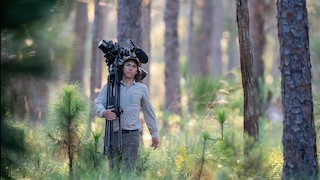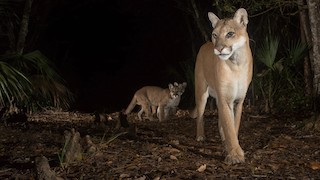 Danny Schmidt is an award-winning director, producer, and cinematographer whose work in wildlife documentaries has taken him to the most remote and forbidding parts of the globe in search of its most elusive creatures. In one of his latest projects, Schmidt served as cinematographer on Path of the Panther, a feature-length documentary directed by Eric Bendick and produced by Carlton Ward, Jr for National Geographic.
Danny Schmidt is an award-winning director, producer, and cinematographer whose work in wildlife documentaries has taken him to the most remote and forbidding parts of the globe in search of its most elusive creatures. In one of his latest projects, Schmidt served as cinematographer on Path of the Panther, a feature-length documentary directed by Eric Bendick and produced by Carlton Ward, Jr for National Geographic.
The film centers on the Florida panther, a rarely seen creature whose habitat is threatened by the ecological degradation of the Everglades. Capturing imagery of a stealthy and potentially dangerous animal like the Florida panther, requires skill, daring and a specialized toolkit.
Over the years, Schmidt has updated his gear with the latest cameras, lighting and other accessories, but one part of his kit has remained consistent, Cartoni’s Focus 22 tripod.
“I’ve used cameras from many manufacturers and have packed any number of combinations of lenses and lights, but the Focus 22 is the one thing I bring everywhere,” says Schmidt, who used Sony’s FS7 camera for the project. “It stands up to trips around the world, across airports, jungles and deserts. It gets dirty and wet. Whenever I go on the road, I pack that tripod.”
 On Path of the Panther, Schmidt waded through mangroves and sawgrass marshes, often at night, in pursuit of the sleek cat and other native animal species.
On Path of the Panther, Schmidt waded through mangroves and sawgrass marshes, often at night, in pursuit of the sleek cat and other native animal species.
“You can’t anticipate when you’re going to encounter the wildlife you want to film,” he observes. “I could be shooting a cinema verite moment with our talent, when a bird, an alligator or a bear appears and I have to quickly deploy my tripod, mount the camera and change lenses. The Focus 22 is the perfect tripod for those situations. If I strip down the camera, it works. If I’m working with a heavy camera, 19 mil rods, dovetail plates, a big lens, and custom accessories, it holds the weight without a struggle. The flexibility is pretty sweet.”
Despite its compact size, Focus 22 has features to accommodate a wide range of accessories and shooting styles. “The whole top plate moves back and forth and can be locked down in any position,” he says. “That’s handy for fine balancing adjustments. It also has a small light that allows me to see the bubble head at night. That might seem like a small thing, but I often find myself shooting into the wee hours because that’s when animals are doing their thing. It’s nice to be able to have light at the push of a button so that I can level the camera and keep moving. Otherwise, I’d have to light it with my phone.”
Schmidt, who’s worked for PBS, National Geographic, Netflix, HHMI BioInteractive, NASA, the National Science Foundation and many others, studied environmental science before pursuing a career in documentary films. Projects like Path of the Panther allow him to indulge both his passion for conservation and his love of filmmaking.
“The work that we did in Florida had one goal: to preserve its wild areas for future generations,” he says. “The Florida panther needs big swaths of open land to survive. Our hope is that this film with have an impact that will help protect these beautiful animals.”
Path of the Panther is currently screening in select theatres in Florida and will soon be available from National Geographic.
Cartoni www.maniosdigital.com
